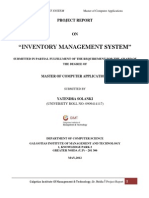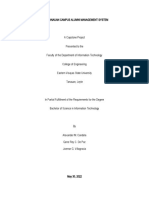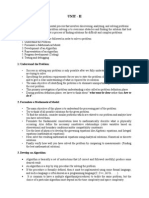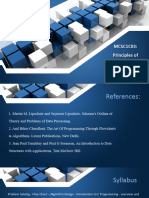0 ratings0% found this document useful (0 votes)
29 viewsLecture 02 - Problem Solving Steps
The document discusses algorithms and problem solving. It explains that algorithms are sets of steps to solve problems and mentions some common algorithm development steps and expressions. It also provides an example algorithm for calculating an average and discusses concepts like pseudo code and flowcharts.
Uploaded by
waheedgxCopyright
© © All Rights Reserved
Available Formats
Download as PPTX, PDF, TXT or read online on Scribd
0 ratings0% found this document useful (0 votes)
29 viewsLecture 02 - Problem Solving Steps
The document discusses algorithms and problem solving. It explains that algorithms are sets of steps to solve problems and mentions some common algorithm development steps and expressions. It also provides an example algorithm for calculating an average and discusses concepts like pseudo code and flowcharts.
Uploaded by
waheedgxCopyright
© © All Rights Reserved
Available Formats
Download as PPTX, PDF, TXT or read online on Scribd
You are on page 1/ 18
Algorithms and Problem
Solving
Lecture 02 – Problem Solving
Steps
AL-Zaiem AL-Azhari University
Faculty of Computer Sciences and Information
Technology
Mohammed Mahmoud
Overview
• A computer cannot solve a problem on its
own.
• One has to provide step by step solutions of
the problem to the computer.
• In fact, the task of problem solving is not
that of the computer. It is the programmer
who has to write down the solution to the
problem in terms of simple operations which
the computer can understand and execute.
Problem Solving Steps
• In order to solve a problem by the
computer, one has to pass though certain
stages or steps. They are
• Understanding the problem
• Analyzing the problem
• Developing the solution
• Coding and implementation.
• Code Validation and Verfication
Using Algorithms to Solve
a Problem
• A set of sequential steps usually written in
Ordinary Language to solve a given
problem is called Algorithm.
• It may be possible to solve to problem in
more than one ways, resulting in more
than one algorithm.
• The choice of various algorithms depends
on the factors like reliability, accuracy and
easy to modify.
Using Algorithms to Solve
a Problem
• The most important factor in the choice
of algorithm is the time requirement to
execute it, after writing code in High-
level language with the help of a
computer. The algorithm which will need
the least time when executed is
considered the best.
Steps involved in algorithm
development
• An algorithm can be defined as “a complete,
unambiguous, finite number of logical steps
for solving a specific problem “
• Step1. Identification of input
• Step2: Identification of output
• Step3 : Identification the processing operations
• Step4 : Processing Definiteness
• Step5 : Processing Finiteness
• Step6 : Possessing Effectiveness
Example
• Suppose we want to find the average of
three numbers, the algorithm is as
follows
• Step 1 Read the numbers a, b, c
• Step 2 Compute the sum of a, b and c
• Step 3 Divide the sum by 3
• Step 4 Store the result in variable d
• Step 5 Print the value of d
• Step 6 End of the program
Example
• Suppose we want to find the average of
three numbers, the algorithm is as
follows
• Step 1 Read the numbers a, b, c
• Step 2 Compute the sum of a, b and c
• Step 3 Divide the sum by 3
• Step 4 Store the result in variable d
• Step 5 Print the value of d
• Step 6 End of the program
Algorithms Expression
• Use Natural Language
• Flowchart
• Pseudo Code
Natural Language
• Natural language is a popular choice,
since it comes so naturally to us and can
convey the steps of an algorithm to a
wide audience.
• When we're developing algorithms, we
are often working both with people who
know programming and those who don't
—but they all know natural language.
Flowchart
• A flow chart is a step by step diagrammatic
representation of the logic paths to solve a given
problem. Or A flowchart is visual or graphical
representation of an algorithm.
• The flowcharts are pictorial representation of the methods
to b used to solve a given problem and help a great deal
to analyze the problem and plan its solution in a
systematic and orderly manner.
• A flowchart when translated in to a proper computer
language, results in a complete program.
Advantages of Flowcharts
1. The flowchart shows the logic of a problem displayed in
pictorial fashion which felicitates easier checking of an
algorithm.
2. The Flowchart is good means of communication to other
users. It is also a compact means of recording an
algorithm solution to a problem.
3. The flowchart allows the problem solver to break the
problem into parts. These parts can be connected to
make master chart.
4. The flowchart is a permanent record of the solution
which can be consulted at a later time.
Symbols used in Flow-
Charts
The symbols that we make use while
drawing flowcharts as given below are
as per conventions followed by
International Standard Organization
(ISO).
1. Oval: Rectangle with rounded sides
is used to indicate either START/
STOP of the program.
2. Input and output indicators:
Parallelograms are used to represent
input and output operations.
Statements like INPUT, READ and
PRINT are represented in these
Parallelograms.
Symbols used in Flow-
Charts
3. Process Indicators: - Rectangle is used
to indicate any set of processing
operation such as for storing
arithmetic operations.
4. Decision Makers: The diamond is used
for indicating the step of decision
making and therefore known as
decision box. Decision boxes are used
to test the conditions or ask questions
and depending upon the answers, the
appropriate actions are taken by the
computer.
Symbols used in Flow-
Charts
5. Flow Lines: Flow lines indicate the
direction being followed in the
flowchart. In a Flowchart, every line
must have an arrow on it to indicate
the direction. The arrows may be in
any direction
Pseudo code
• The Pseudo code is neither an algorithm nor a program.
It is an abstract form of a program. It consists of English
like statements which perform the specific operations. It
is defined for an algorithm.
• It does not use any graphical representation. In pseudo
code, the program is represented in terms of words and
phrases, but the syntax of program is not strictly
followed.
• Advantages: * Easy to read, * Easy to understand, *
Easy to modify.
General Problem Solving
Strategies
• Divide and Conquer
• Decrease and Conquer
• Transform and Conquer
• Greedy Method
• Dynamic Programming
END!
You might also like
- Inventory Management System Project ReportNo ratings yetInventory Management System Project Report108 pages
- EVSU Tanauan Campus Alumni Management SystemNo ratings yetEVSU Tanauan Campus Alumni Management System79 pages
- Problem Solving Technique using ComputerNo ratings yetProblem Solving Technique using Computer29 pages
- Lesson 10 - Introduction To Computer Programming (Algorithms and Flowcharts)No ratings yetLesson 10 - Introduction To Computer Programming (Algorithms and Flowcharts)26 pages
- Introduction To Algorithms: Unit 1 / Chapter 1No ratings yetIntroduction To Algorithms: Unit 1 / Chapter 134 pages
- Algorithm and Flowchart: Computer Programming (Object Oriented Programming)No ratings yetAlgorithm and Flowchart: Computer Programming (Object Oriented Programming)31 pages
- Chapter Four Problem Solving Using ComputersNo ratings yetChapter Four Problem Solving Using Computers16 pages
- Steps in Problem Solving and Algorithm and It's RepresentationNo ratings yetSteps in Problem Solving and Algorithm and It's Representation16 pages
- 22CS110 - 210-Unit-1 - Art of Programming Through Algorithms and Flowcharts100% (1)22CS110 - 210-Unit-1 - Art of Programming Through Algorithms and Flowcharts7 pages
- Lecture 1.0 - Introduction To Program Design and DevolopmentNo ratings yetLecture 1.0 - Introduction To Program Design and Devolopment8 pages
- Algorithm: Why Should We Study Algorithms?No ratings yetAlgorithm: Why Should We Study Algorithms?12 pages
- Introduction To: Algorithms & FlowchartsNo ratings yetIntroduction To: Algorithms & Flowcharts26 pages
- PRACTICAL GUIDE TO LEARN ALGORITHMS: Master Algorithmic Problem-Solving Techniques (2024 Guide for Beginners)From EverandPRACTICAL GUIDE TO LEARN ALGORITHMS: Master Algorithmic Problem-Solving Techniques (2024 Guide for Beginners)No ratings yet
- Algorithms Made Simple: Understanding the Building Blocks of SoftwareFrom EverandAlgorithms Made Simple: Understanding the Building Blocks of SoftwareNo ratings yet
- Ict - Computer Hardware Servicing Curriculum Guides For Grades 7 To 10100% (1)Ict - Computer Hardware Servicing Curriculum Guides For Grades 7 To 1023 pages
- Subject Name: Data Structure II Subject Code: CS-3004 Semester: 3No ratings yetSubject Name: Data Structure II Subject Code: CS-3004 Semester: 310 pages
- Important Questions For Viva Programming in C: Chapter 1: IntroductionNo ratings yetImportant Questions For Viva Programming in C: Chapter 1: Introduction5 pages
- E006744-1708447829965-406099-FC6P01ES - Final Project Proposal THIVYA Interim Report NewNo ratings yetE006744-1708447829965-406099-FC6P01ES - Final Project Proposal THIVYA Interim Report New33 pages
- IELTS Listening - Flow Chart Completion - Transcript Answer - GlobalNo ratings yetIELTS Listening - Flow Chart Completion - Transcript Answer - Global3 pages
- Ais Master Reviewer 1 8 Accounting Info System Test BankNo ratings yetAis Master Reviewer 1 8 Accounting Info System Test Bank59 pages
- Lesson 10 - Introduction To Computer Programming (Algorithms and Flowcharts)Lesson 10 - Introduction To Computer Programming (Algorithms and Flowcharts)
- Algorithm and Flowchart: Computer Programming (Object Oriented Programming)Algorithm and Flowchart: Computer Programming (Object Oriented Programming)
- Steps in Problem Solving and Algorithm and It's RepresentationSteps in Problem Solving and Algorithm and It's Representation
- 22CS110 - 210-Unit-1 - Art of Programming Through Algorithms and Flowcharts22CS110 - 210-Unit-1 - Art of Programming Through Algorithms and Flowcharts
- Lecture 1.0 - Introduction To Program Design and DevolopmentLecture 1.0 - Introduction To Program Design and Devolopment
- PRACTICAL GUIDE TO LEARN ALGORITHMS: Master Algorithmic Problem-Solving Techniques (2024 Guide for Beginners)From EverandPRACTICAL GUIDE TO LEARN ALGORITHMS: Master Algorithmic Problem-Solving Techniques (2024 Guide for Beginners)
- Algorithms Made Simple: Understanding the Building Blocks of SoftwareFrom EverandAlgorithms Made Simple: Understanding the Building Blocks of Software
- Ict - Computer Hardware Servicing Curriculum Guides For Grades 7 To 10Ict - Computer Hardware Servicing Curriculum Guides For Grades 7 To 10
- Subject Name: Data Structure II Subject Code: CS-3004 Semester: 3Subject Name: Data Structure II Subject Code: CS-3004 Semester: 3
- Important Questions For Viva Programming in C: Chapter 1: IntroductionImportant Questions For Viva Programming in C: Chapter 1: Introduction
- E006744-1708447829965-406099-FC6P01ES - Final Project Proposal THIVYA Interim Report NewE006744-1708447829965-406099-FC6P01ES - Final Project Proposal THIVYA Interim Report New
- IELTS Listening - Flow Chart Completion - Transcript Answer - GlobalIELTS Listening - Flow Chart Completion - Transcript Answer - Global
- Ais Master Reviewer 1 8 Accounting Info System Test BankAis Master Reviewer 1 8 Accounting Info System Test Bank

























































































